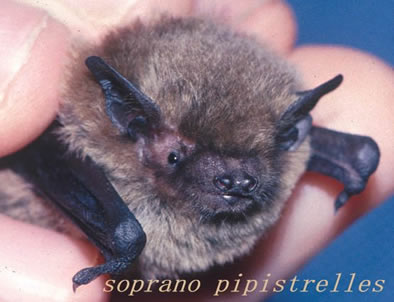Urban bats
While relatively few bat species forage in urban gardens, houses are popular roost sites. Both common and soprano pipistrelles roost in buildings in built-up areas. If you see them at all, they are likely to be flying into white street lights to catch insects or hawking over garden ponds.
buildings in built-up areas. If you see them at all, they are likely to be flying into white street lights to catch insects or hawking over garden ponds.
Maternity roosts are usually on the south or south-west sides of buildings, presumably because these are the warmest places. Large pipistrelle maternity roosts can host several hundred bats.
Which species of bat in that house?
Brown long-eared bats are the species most likely to use bat boxes, especially for breeding. They are easy to identify from their slow fluttering flight and the way they hover to pick insects off the leaves of garden trees. They are occasionally even seen fluttering outside windows, picking up insects attracted to the lights, and may hang up in the porches of houses to eat, leaving a pile of discarded wings and faeces.
Larger species such as Leisler’s bats and serotines sometimes breed in houses in urban areas, but generally they fly off to feed in nearby rural locations. However, both species can be seen hunting around white street lights, and Leisler’s sometimes forage along urban canals. Bats prefer clean, draft-free buildings, disliking dust and cobwebs.
There is one plus for urban bats....Bats in urban areas are less affected by disease because they tend to hibernate in man-made structures that stay warmer than caves. And migratory species, like the Hoary Bat, do not spend the same amount of time in caves as bats that hibernate, and therefore have limited interaction with the fungus. Given current trends, urban bats are likely to become the majority population since they are less likely to be exposed to white-nose syndrome..
More about White-Nose Syndrome, are urban bats the answer?
With white nose syndrome becoming what it is and with deforestation and habitat destruction happening, a lot of people are coming to the realization that urban populations may be critical for bats. Groups are starting new initiatives to help urban bats. Populations of bats are dying off, but those in urban areas aren’t as affected by white nose syndrome. Just like it happened in Europe, there is a chance those urban bat populations that live with us could be the strongest and most robust populations left. This provides a big opportunity in the realm of bat research. The initiative will focus on active education through the community about the bat population. Involving residents in constructing bat houses in the city and starting wildlife gardens, in hopes of better understanding why and how the urban bat populations have been less affected by the fungus. This is an opportunity for researchers and citizens to connect with urban wildlife. There is even a huge variety in urban bat species....some rarely use gardens and some will roost in large old houses, but forage in wooded parks and along canals and rivers. Some bats, for example, are closely associated with still or slowmoving water, even in built-up areas.
It’s easy to forget that bats can be common in urban areas as well as in the countryside. It’s exciting to see them swooping over a pond catching insects on a summer evening, but what can you do to attract them to your city yard?Well, unfortunately, the truth is that your options are limited but researchers are working on a plan.. Even if you have bats roosting in your house, all you will probably see is them spilling out at dusk and disappearing off to their feeding sites. Your best bet would be to start looking for bats in your local area and then think about how to make your yard more appealing to them.



